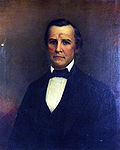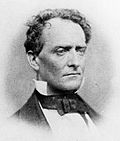| Member | Party | Years | Cong
ress | Electoral history |
|---|
| District created August 1, 1836, after achieving statehood. |

Archibald Yell
(Fayetteville) | Jacksonian | December 14, 1836 –
March 3, 1839 | 24th
25th | Elected in 1836 to finish the short term.
Re-elected in 1837.
Retired. [1] |
| Democratic |
Edward Cross
(Washington) | Democratic | March 4, 1839 –
March 3, 1845 | 26th
27th
28th | Elected in 1838.
Re-elected in 1840.
Re-elected in 1842.
Retired. [2] |

Archibald Yell
(Fayetteville) | Democratic | March 4, 1845 –
July 1, 1846 | 29th | Elected in 1844.
Resigned to serve in the United States Volunteers. |
| Vacant | July 1, 1846 –
February 6, 1847 | |
Thomas W. Newton
(Little Rock) | Whig | February 6, 1847 –
March 3, 1847 | Elected to finish Yell's term.
Retired. |

Robert W. Johnson
(Little Rock) | Democratic | March 4, 1847 –
March 3, 1853 | 30th
31st
32nd | Elected in 1846.
Re-elected in 1848.
Re-elected in 1851.
Retired. |
| Vacant | March 4, 1853 –
March 3, 1873 | 33rd
34th
35th
36th
37th
38th
39th
40th
41st
42nd | Civil War and Reconstruction |

William J. Hynes
(Little Rock) | Liberal Republican | March 4, 1873 –
March 3, 1875 | 43rd | Elected in 1872.
Lost re-election. |
| Vacant | March 4, 1875 –
March 3, 1883 | 44th
45th
46th
47th | Seat inactive. |

Clifton R. Breckinridge
(Pine Bluff) | Democratic | March 4, 1883 –
March 3, 1885 | 48th | Elected in 1882.
Redistricted to the 2nd district . |
| District eliminated March 4, 1885 |